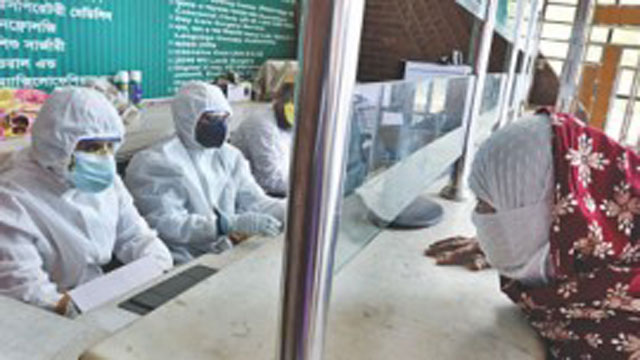Two major public hospitals in Dhaka had concentrations of harmful air pollutants 10 times higher than the permissible limit in winter, finds a new study.
The indoor air quality of the healthcare installations during the pre-monsoon period remained two times worse than the permissible limit recommended by the World Health Organization and Bangladesh national ambient air quality standards (NAAQS).
The study was based on the air quality of Dhaka Medical College Hospital (DMCH), Bangabandhu Sheikh Mujib Medical University (BSMMU) and Sonargaon Upazila Health Complex in Narayanganj.
Air quality was monitored in 16 locations of the three health care installations between October 2019 and January 2020, said the report published in the journal of Environmental Science and Pollution Research on March 15.
"Outdoor air has a significant impact on the hospitals' indoor air quality," said the study titled "Indoor air quality indicators and toxicity potential at the hospitals' environment in Dhaka, Bangladesh".
According to a global report published on Wednesday, air quality of Bangladesh was the worst in the world, while its capital Dhaka was the second worst air polluted city last year.
The study on the three health care institutions was conducted by health care professionals and academicians in two periods -- pre-monsoon and winter. It found that air quality remains worse during both the periods.
For example, the average concentration of PM 2.5 at the three healthcare institutions was 52.28 μg/m3 during pre-monsoon which is double than the NAAQS permissible limit.
In winter, the average concentration of PM 2.5 was 222.53 μg/m3 which is around eight times higher than the NAAQS permissible limit, the report said.
The WHO's ambient air quality permissible standard is 25 μg/m3 while it is 55 μg/m3 for NAAQS.
Speaking to Prof Abdus Salam, key author of the study and also a chemistry teacher at Dhaka University, said indoor air quality worsens due to various activities of the people and it indicates the unhygienic condition at hospitals.
To improve the indoor air quality at government hospitals, the authorities concerned should focus on the overall hygiene situation and reduce crowding by patient's attendants at hospitals, he added.
The first-of-its-kind study on indoor air quality of hospitals in the country also said toxicity potential (TP) values at the three installations were 10 times higher than normal, which means the environment there could aggravate patients' health.
The TP indicates the overall environment of a place.
"Extremely high TP values indicated potential severe health consequences of the healthcare professionals and patients in indoor hospitals environment," the report said.
The children's surgery ward site showed higher particulate matter (PM) concentrations than other indoor sampling locations at the DMCH. The ward was most crowded and filthy among all the sites in the hospital, the study found.
It also said unhygienic environment and movement of people increased outdoor particulate concentrations inside the hospitals.
Prof Salam said proper ventilation can improve the air quality inside the hospitals, adding that cooking inside the wards should be stopped.
Contacted, DMCH Director Brig Gen Nazmul Haque said they were working on improving the environment inside the hospital.
"The hospital is overcrowded and people's movement is big inside the hospital. We try to keep our hospital clean but it is not possible to keep it clean all the time especially when the hospital is overcrowded," he told.
Be-Nazir Ahmed, former director (disease control) at the Directorate General of Health Services, said poor air quality inside a hospital indicates that there is high possibility of infection which is dangerous.
"The hospital authorities must identify the sources of dust. There is no alternative to cleanliness. There is a serious lack of cleaners at hospitals. We have to engage more cleaners in keeping the hospitals clean."
Modern equipment should be used to make the indoor environment clean, he added.
Indoor and outdoor air pollution led to 1.23 lakh deaths in Bangladesh in 2017, according to a study titled The State of Global Air 2019.
Long-term exposure to outdoor and indoor air pollution contributed to nearly five million deaths from stroke, diabetes, heart attack, lung cancer and chronic lung disease in 2017.
mj/





